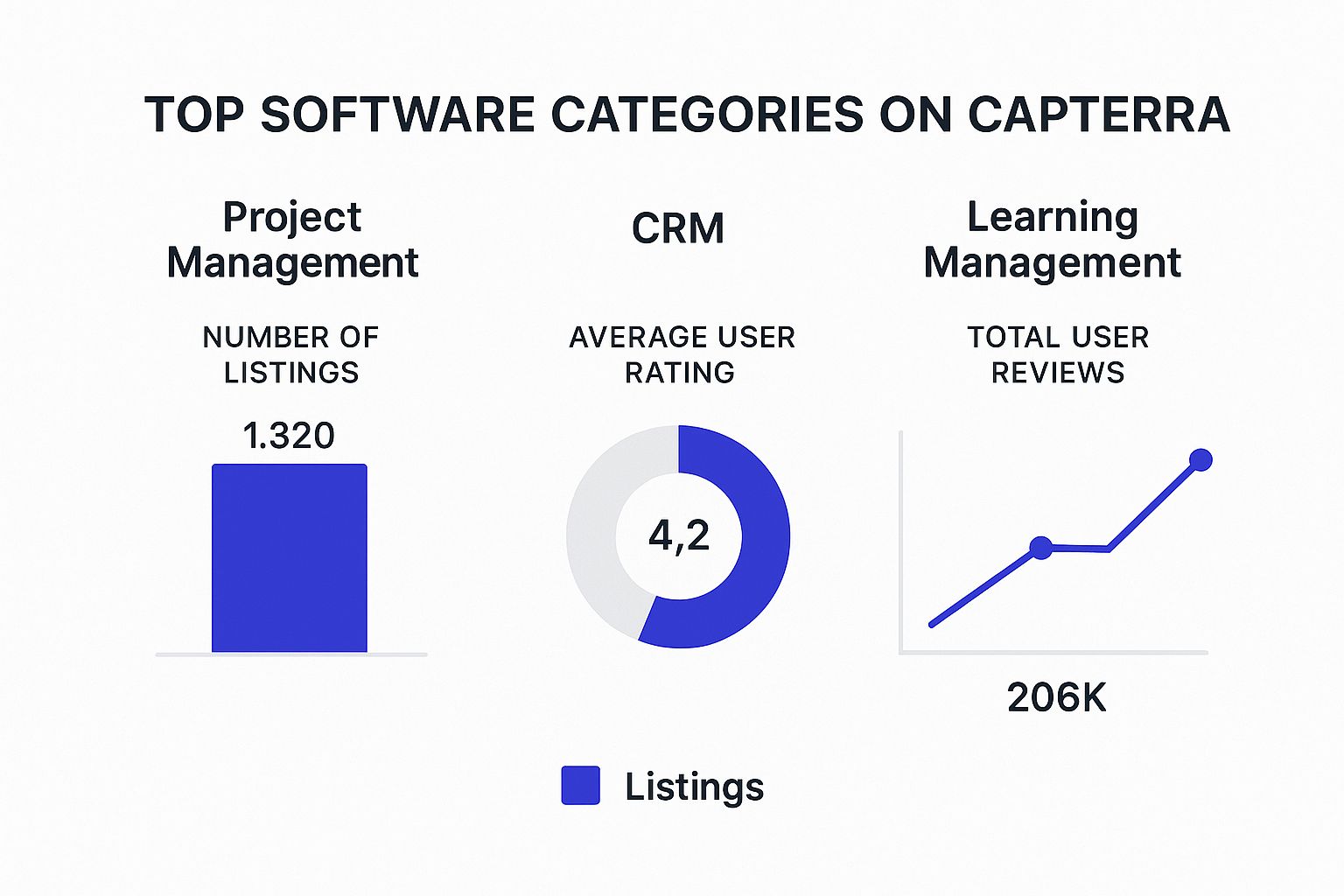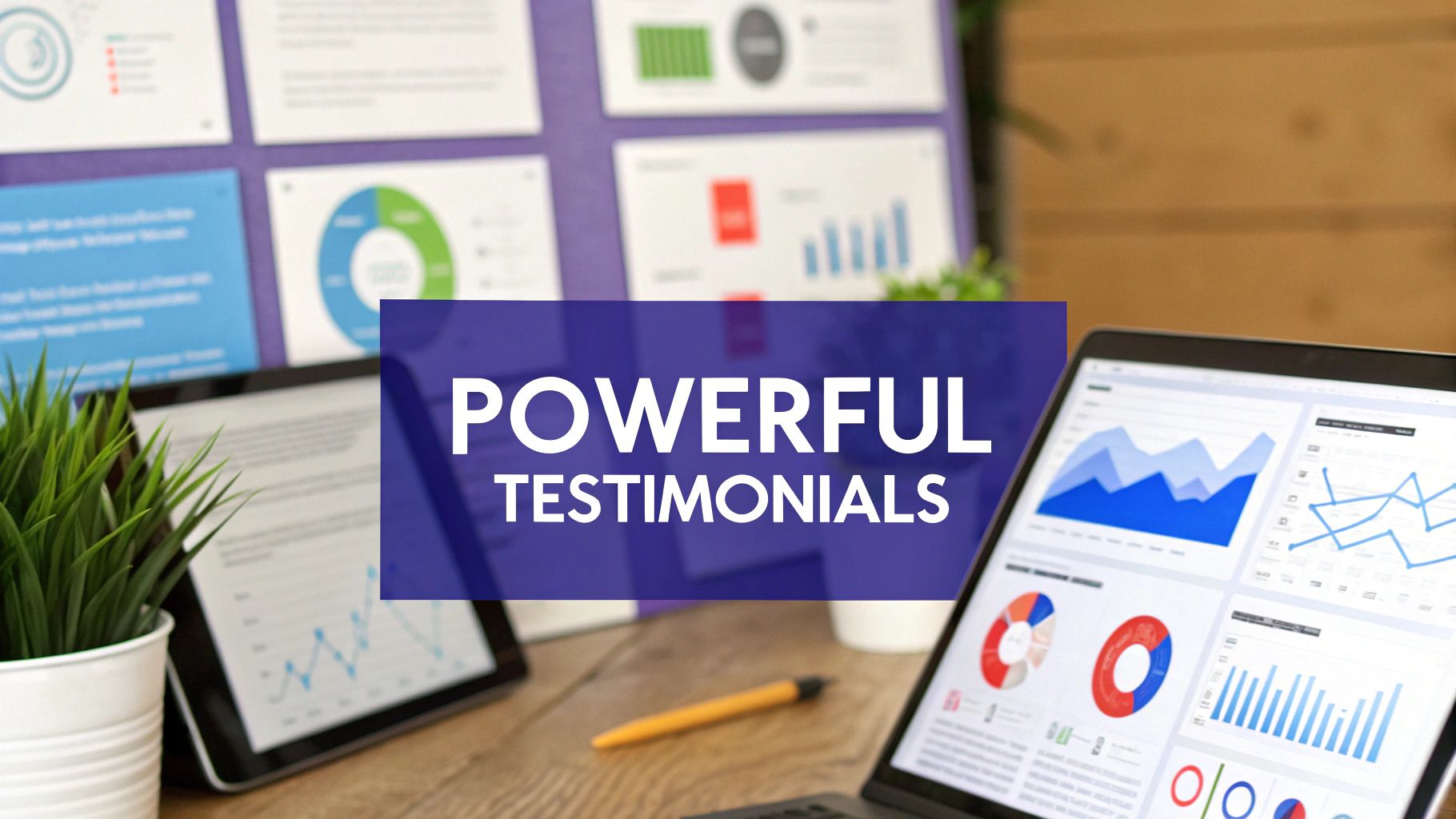Capterra Guide: Boost SaaS Growth & Get More Leads
Discover how to optimize your Capterra profile, gather reviews, and attract high-quality SaaS leads with our comprehensive guide.

Think of Capterra as the ultimate digital showroom for business software. It’s a bustling marketplace where companies actively hunting for new tools can connect directly with the SaaS vendors who build them. It's more than just a simple directory; for businesses ready to compete, Capterra is a high-intent lead generation engine.
What Is Capterra and How Does It Work?
To really get what Capterra is all about, you have to see it as a key player in the wider world of a software marketplace for SaaS. At its heart, Capterra takes the often overwhelming process of buying software and makes it simple. It meticulously organizes thousands of software solutions into specific, easy-to-browse categories, from "CRM Software" to "Project Management Tools."
For a business buyer, the journey is refreshingly direct. They land on the site, find the category they need, and are instantly met with a list of top-rated solutions.
This is what a user sees when they land on a category page.

From there, users can filter the options, compare features side-by-side, and—most importantly—read through tons of verified user reviews.
To help you visualize how all the pieces fit together, let's break down the platform's core functions for both buyers and sellers.
Capterra's Core Components at a Glance
This table shows how Capterra creates a balanced ecosystem, serving the distinct needs of those looking for software and those selling it.
The Power of Reviews and PPC
Reviews are the absolute lifeblood of the platform. They provide the social proof that buyers desperately need to make confident, informed decisions. For SaaS vendors, this review ecosystem is an incredibly powerful asset. A healthy collection of positive, authentic feedback can dramatically boost your visibility and credibility within your category.
But visibility isn't just left up to chance or review volume. Capterra runs primarily on a Pay-Per-Click (PPC) model. This means SaaS vendors can bid for higher placement on the category pages. When a user clicks on your listing to check out your website, you pay a fee.
This model creates a powerful incentive. The people clicking through aren't just window shopping; they are actively evaluating solutions, making them some of the highest-intent leads you can possibly find.
The combination of authentic user reviews and a competitive PPC system is what makes the marketplace so dynamic and effective. It’s a win-win: buyers reduce the risk of picking the wrong software, and vendors get a cost-effective way to reach their ideal customers right when they’re ready to buy. This balanced approach is precisely what has cemented Capterra’s spot as a dominant force in B2B software discovery.
Building a Capterra Profile That Converts

Think of your Capterra profile as your digital storefront in a massive, bustling software mall. If it's half-empty or generic, it’s like a shop with bare shelves—it tells buyers you're not really open for business. To grab those high-intent leads, you need a profile that doesn’t just get eyeballs but actually turns visitors into customers.
This is more than just checking boxes and filling in fields. It's about creating a powerful first impression that instantly clicks with a buyer, answering their biggest questions before they even have to ask. A killer profile doesn't just list what your software does; it shows prospects the real-world value it delivers.
Crafting a Compelling Product Description
Your product description is your elevator pitch. It has to be sharp, benefit-focused, and written for the way real people search on Capterra. The biggest mistake you can make is leading with a boring list of features. Instead, kick things off by hitting on the core pain points your ideal customer is struggling with and then show them how your software is the solution.
You’ll want to structure your description so it’s easy to skim. Use short, punchy paragraphs and bullet points to make your key outcomes and what makes you different jump off the page.
- Lead with benefits, not features. Instead of saying, "Our tool has an analytics dashboard," try something like, "Get instant visibility into your most important metrics with our intuitive analytics dashboard." See the difference?
- Speak their language. Use the same words and phrases your customers would use to talk about their problems and the solutions they’re looking for.
- Signal who it's for. Be upfront about your target audience. A simple line like "Built for SaaS product managers" or "The perfect solution for small marketing agencies" helps the right people self-select and immediately connect with your product.
This approach ensures the right buyers know they're in the right place, making your solution feel instantly relevant to their specific needs.
Showcasing Your Software with Visuals
In 2024, visuals are absolutely non-negotiable for a profile that converts. They're the tangible proof of what your product can do and what it feels like to use it. High-quality screenshots and short videos can seriously boost engagement and help buyers picture themselves using your tool.
It’s not just a hunch. One study on user behavior found that content with relevant images gets 94% more views than content without. On a crowded platform like Capterra, that visual edge is everything.
Your visual gallery should tell a story, guiding potential customers through your software’s most valuable features and workflows.
- Product Screenshots: Don't just upload random screenshots. Upload clear, annotated images that put a spotlight on key features in action. Show off your UI and make it obvious how easy it is to get things done.
- Walkthrough Videos: Put together a short (think 1-2 minute) video tour of your software. Focus on the core value you provide and wrap it up with a clear call to action.
Think of your profile as a guided demo. Every single element, from the words you write to the images you choose, should work together to build a prospect's confidence and move them from just looking to actually buying. A great profile doesn't just get found—it convinces.
And don't forget to keep your profile fresh. As you roll out new features or give your UI a facelift, make sure to update your screenshots and videos to match. A current profile sends a strong signal that your company is active, always improving, and listening to customers, which builds even more trust with buyers browsing Capterra.
How To Get More Customer Reviews (And Why You Should)
On Capterra, social proof is king. Your customer reviews are the engine that builds trust, and they're often the single biggest factor that sways a buyer’s decision. If you're serious about growing your SaaS on the platform, building a strong portfolio of authentic reviews isn't just a nice-to-have—it's a core part of your strategy.
The aim here is to create a steady, ethical flow of genuine feedback from your users. This isn't about chasing a perfect five-star score. In fact, a mix of glowing reviews and constructive criticism often feels more authentic to savvy buyers than a flawless record.
Just look at how Capterra lays out its review pages. User feedback is absolutely central to how people discover and compare software.

Notice how ratings, review counts, and direct user quotes are right there, front and center? They shape a potential customer's first impression.
Timing Your Review Request
When it comes to asking for a review, timing is everything. A poorly timed request is easy to ignore, but a well-timed one feels like a natural next step for a happy customer. You want to pop the question when the value of your product is fresh in their mind.
Think about asking at these key moments:
- After a Customer Success Win: Did a user just get a tricky issue solved by your support team? Their positive feelings are at a peak. That’s a great time to ask.
- Following a Key Milestone: Maybe a user just wrapped up a big project or hit a major ROI milestone using your tool. Capitalize on that "aha!" moment.
- During a Renewal or Upgrade: When a customer commits to another year or moves to a higher-tier plan, they’re clearly seeing value. That’s a perfect signal.
By weaving your review requests into these high-satisfaction points of the customer journey, you dramatically boost your chances of getting a positive, detailed response. For more great ideas, this guide offers proven tips on how to get customers to leave reviews.
Responding to Every Single Review
Getting reviews is only half the job. The way you respond—to both the good and the bad—is a public display of your company's character and how much you care about your customers. A smart response strategy can turn every single review into a marketing opportunity.
Responding to reviews shows you're actually listening. It signals to potential buyers that you value feedback and are actively engaged with your users. This public conversation builds a ton of trust.
For the good reviews, thank the user personally and highlight the specific value they pointed out. For the critical ones, thank them for their honesty, acknowledge their issue without getting defensive, and offer to take the conversation offline to fix it. This kind of public accountability can be more convincing than a dozen five-star reviews.
To really dig into the details of managing your online reputation, check out our complete guide to handling your Capterra review strategy. This approach transforms your Capterra listing from a static page into a dynamic, ongoing conversation that wins over new customers.
Mastering Capterra PPC Campaigns for Lead Gen
Okay, so your Capterra profile is polished and ready to go. Now what? It's time to flip the switch on your lead generation engine.
Think of Capterra’s Pay-Per-Click (PPC) advertising as the tool that turns your listing from a static digital storefront into a dynamic machine that actively pulls in high-intent buyers. It’s like moving your shop from a quiet side street right to the main entrance of the mall where all the action is.
The system might sound a bit technical, but the core idea is simple. You bid for better placement within your software category. When a potential buyer clicks on your listing to check out your website, you pay a fee—the Cost-Per-Click (CPC). The magic here is that these aren't just random clicks. They're from people actively shopping for and comparing solutions like yours, making them some of the most valuable leads you can get.
Setting Your Budget and Bids
First things first: you need a smart budget. Don't go all-in right away. Start with a modest daily or monthly cap you’re comfortable with. This lets you dip your toes in the water and gather some real-world performance data without a massive upfront risk. Once you see what's working, you can scale your spending with confidence.
Next up is your bid. Capterra’s PPC auction is straightforward—it’s based on who is willing to pay the most for a click. Generally, higher bids land you higher up on the page, which means more eyeballs on your listing. But the goal isn't just to be #1. It's to find that sweet spot where your bid delivers a profitable Cost-Per-Lead (CPL).
A solid starting strategy is to set a bid that gets you meaningful traffic without burning through your budget on day one.
This infographic breaks down some key data points for Capterra's most popular software categories, giving you a feel for the landscape.

As the data shows, the more popular a category is, the more competition you'll face. This directly impacts everything from the number of reviews you need to stand out to the potential CPCs you'll be paying.
Choosing Your Capterra Bidding Strategy
Your bidding strategy shouldn't be a shot in the dark. It needs to align directly with what you're trying to achieve—whether that's maximum visibility, lead quality, or budget efficiency. The table below breaks down a few common goals and the bidding strategies that best support them.
Choosing the right approach from the start helps you focus on the metrics that matter most, making it easier to gauge success and make smart adjustments down the line.
Managing Your Campaigns for Positive ROI
Launching your campaign is just the starting line. The real work—and where the real results come from—is in the ongoing management and optimization. Your Capterra dashboard is your command center, packed with all the data you need to make smart, informed decisions.
The most successful Capterra advertisers are not the ones who “set it and forget it.” They are the ones who consistently analyze their campaign performance, test new approaches, and adjust their bids to maximize return on investment.
Here are the essential steps for keeping your campaigns healthy and profitable:
- Monitor Key Metrics: Keep a close eye on your CPC, CPL, click-through rate (CTR), and conversion rate. These numbers are the vital signs of your campaign; they tell you exactly what’s working and what isn’t.
- Analyze Performance: Regularly review which categories are driving your best leads. If one category is a goldmine, consider increasing your bid there. If another is bringing in clicks but no conversions, it might be time to lower your bid or pause it altogether.
- Optimize and Iterate: Use the insights you gather to constantly refine your strategy. This continuous feedback loop is what turns your PPC spend into a predictable, reliable source of growth. Many of the foundational tactics for general PPC campaign optimization apply directly here and can give you a great head start.
Ultimately, getting a handle on Capterra PPC is a core part of modern SaaS growth strategies. It gives you a direct line to buyers at the exact moment they're ready to make a decision.
Common Capterra Mistakes You Must Avoid
Getting your SaaS business listed on Capterra is a fantastic first step. But it's not a "flick a switch and watch the leads roll in" kind of deal. Far too many companies invest time and money into a listing, only to wonder why it’s not delivering. More often than not, they’re falling for a few common—and completely avoidable—traps.
The biggest mistake I see? The ‘set it and forget it’ approach. It's like opening a brand-new retail store and then never restocking the shelves, dusting, or even talking to the people who walk in. Your Capterra profile isn't a static brochure; it’s a living, breathing asset that demands attention.
Neglecting Reviews and Bidding Blindly
Another major pitfall is completely ignoring customer reviews. Every single piece of feedback, whether it’s glowing praise or a stinging critique, is a golden opportunity. It’s your chance to show prospective buyers that you listen, you care, and you’re dedicated to your users. Ghosting your reviewers sends the opposite message, and that’s a huge red flag for anyone vetting your software.
Equally damaging is bidding for PPC ads in the wrong categories. Throwing your marketing budget at a hyper-competitive category before you've built up a solid base of reviews is like a small sailboat trying to race a fleet of destroyers. You're just burning cash.
The goal isn't just to get clicks; it's to get the right clicks that turn into real customers. An optimized Capterra profile gets clicks that convert, not just empty traffic that drains your ad spend.
The Real Cost of an Unmanaged Profile
When you add it all up, these missteps lead to a profile that’s full of leaks. You might get some traffic, but if your product description is stale or your reviews are sitting unanswered, those potential leads will bounce right off the page. A winning Capterra strategy is about more than just showing up—it’s about actively playing the game.
To see a real return on your efforts, you need to be hands-on.
- Proactively manage your listing: Keep it fresh with updated screenshots, new feature announcements, and relevant details.
- Engage with every review: Turn feedback into a public showcase of your excellent customer service.
- Bid strategically: Put your budget where it has the best chance of winning high-quality, convertible leads.
Putting consistent effort into these areas is what turns a simple listing into a powerful lead-generation engine. This kind of proactive management doesn't just win new business; it also has a major impact on user loyalty. Our guide on effective customer retention strategies dives deeper into how this kind of active engagement keeps your users happy for the long haul.
The Capterra Story and Its Rise to Dominance
Every big name in tech has an origin story, and Capterra's is a real lesson in seeing a market need and sticking with it. It all started with a simple but powerful idea: help businesses cut through the noise and confusion of buying software.
But its path to becoming a go-to resource in the B2B world was anything but a straight line.
Founded back in 1999 by Michael Ortner and Rakesh Chilakapati, the goal was to build a one-stop shop for businesses hunting for the right tools. The early years were a grind. In fact, it took them nearly two years just to land their first two paying customers. It’s a classic startup struggle, a testament to just how tough it is to build a new marketplace from the ground up. You can get more of the inside scoop on Capterra's early days and its founders' journey on sentventures.com.
The Pay-Per-Click Turning Point
The real breakthrough came when Capterra embraced a pay-per-click (PPC) model. This was a brilliant move, perfectly timed with the explosive growth of Google and online search. Suddenly, Capterra wasn't just a static directory anymore. It transformed into a dynamic marketplace where software vendors could pay to get right in front of highly motivated buyers.
This strategic pivot was the rocket fuel Capterra needed. After four software vendors signed on in 2002, the model was proven, and the company’s future looked completely different. It kicked off a flywheel effect: more vendors brought in more reviews, which pulled in more buyers, which in turn attracted even more vendors.
This journey—from a scrappy startup fighting for every dollar to a Gartner-owned powerhouse—gives you crucial context. It’s why the PPC model and user reviews are baked so deeply into the platform’s DNA.
Understanding this history is a huge advantage for any SaaS company trying to make a mark on the platform today. Capterra wasn't just built to list software; it was engineered from day one to be a competitive arena. It rewards vendors who lean into reviews, invest smartly in their visibility, and get that they are competing for attention right when buyers are ready to pull the trigger. The platform's past absolutely shapes its present, and it defines the rules of the game for everyone.
Got Questions About Capterra? We’ve Got Answers.
When you're first dipping your toes into Capterra, it's natural for a few questions to pop up. Let's clear up some of the most common ones that SaaS vendors have right from the start.
Is Capterra Free for Vendors to Use?
Yes and no. It’s a bit of a mixed bag, but in a good way.
Getting your basic profile up and running on Capterra is completely free. This gets your software listed in their massive directory, lets you flesh out your product details, and—most importantly—allows you to start collecting user reviews without spending a dime. Think of it as your foot in the door.
But if you want to move from just being on the platform to actually being seen, you'll need to look at their paid Pay-Per-Click (PPC) program. This is how you bid for those prime spots in your category. So, while the free listing gets you in the game, the paid program is what gets you noticed.
How Much Does Capterra PPC Cost?
This is the million-dollar question, and the honest answer is: it depends. The cost for Capterra's PPC ads can swing wildly based on how crowded and competitive your software category is.
In some less competitive niches, you might pay just a few dollars per click. But for the heavy hitters like CRM or project management software, be prepared for clicks that can climb to over $50.
The good news is, you're always in the driver's seat. You set the maximum cost-per-click you’re willing to pay and a total budget cap. This ensures you never accidentally blow past your marketing spend.
Can I Remove a Bad Review from My Profile?
The short answer is no. You can't just delete a negative review because you disagree with it. Capterra’s reputation is built on authentic, unfiltered user feedback, and they guard that trust fiercely.
However, you're not completely powerless. If you suspect a review is fake, from a competitor, uses inappropriate language, or otherwise violates their guidelines, you can flag it for investigation. Capterra's team will take a look and remove it if it breaks the rules.
Your best move? Respond to the review publicly and professionally. It shows potential buyers that you listen, you care, and you’re committed to making things right.
Ready to turn customer feedback into your biggest growth driver? Surva.ai gives you the tools to understand your users, reduce churn, and collect powerful testimonials. Start your free trial today!


